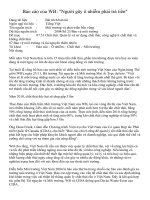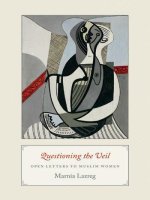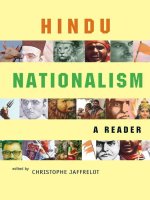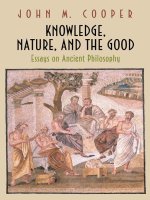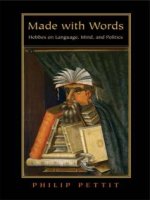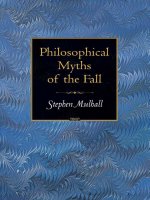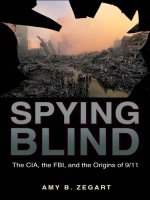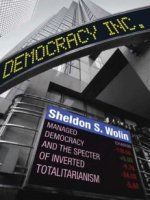Princeton WB OChem
Bạn đang xem bản rút gọn của tài liệu. Xem và tải ngay bản đầy đủ của tài liệu tại đây (6.22 MB, 128 trang )
MCAT SciENCE WoRKBOOK
TABLE OF CONTENTS
PERIODIC TABLE OF THE ELEMENTS .......................................................
4
BIOLOGY
QuESTIONS AND PAssAGEs .................•....................•..•..••....•.•.•.....•
SOLUTIONS..............................................................................
5
139
PHYSICS
QuESTIONS AND pAS SAGES ......••....•...............•..•......•..•..•.......•....
223
SoLUTIONS ..............................................................................
353
GENERAL CHEMISTRY
QuESTIONS AND PASSAGES .........................................................
431
SoLUTIONS .....•...•..•.•.....•.......•..•........•......•........•...•....•.•..........
569
ORGANIC CHEMISTRY
QuESTIONS AND PASSAGES .........................................................
639
SoLUTIONS ..............................................................................
731
MCAT SciENCE
WoRKBOOK
2
PASSAGE GUIDE
BIOLOGY
Chapter
Number
1
2
3
4
5
6
7
8
9
10
MCAT Biological Sciences Review
MCAT Biology Chapter Title
Corresponding MCAT Science Workbook
Passage Numbers
Molecular Biology
Microbiology
Generalized Eukaryotic Cells
Genetics and Evolution
Nervous and Endocrine Systems
Circulatory, Lymphatic, and Immune Systems
Digestive and Excretory Systems
Muscle and Skeletal Systems
Respiratory and Skin Systems
Reproductive Systems and Development
5, 12, 16, 18, 23,25, 27-32,55
13, 17, 19, 20, 21, 26, 34,35
1,2, 4,6, 7,10,24
33,56,62, 63,64, 65,66
8,9, 15,22,38,39,58,59,67-74
40,42,43,44,45, 46,47,61, 75
14,57, 76, 77,78
41,48,49,50,51,60, 79
52,53,54, 80
3, 11, 36,37,81, 82,83
MCAT Physical Sciences Review
MCAT Physics Chapter Title
Correspond;ng MCAT Science Workbook
Passage Numbers
Kinematics
Mechanics I
Mechanics II
Mechanics Ill
Fluids and Elasticity of Solids
Electrostatics
Electricity and Magnetism
Oscillations and Waves
Sound
Light and Geometrical Optics
11 2
PHYSICS
Chapter
Number
1
2
3
4
5
6
7
8
9
10
4
3-9, 15-18
1Q-13, 19-24
31,32
25-30,33-39
14,40,45,46,48-55
42,43,56,57
41,44,47,58-60
GENERAL CHEMISTRY
Chapter
Number
1
2
3
4
5
6
7
8
9
10
MCAT Physical Sciences Review
MCAT General Chemistry Chapter Title
Corresponding MCAT Sqience Workbook
Passage Numbers
Atomic Structure
Periodic Trends and Bonding
Phases
Gases
Solutions
Kinetics
Equilibrium
Acids and Bases
Thermodynamics
Redox and Electrochemistry
1-4,6,9-18,70
5, 7,19-28,43,72
35,57,59, 60,62, 63,65,66
40,61,64, 67
31,41, 42, 45,68, 69
33,44, 71
29,37,39,46
30,32,34,36,38,47-55
58, 73-78
8,56, 79-91
ORGANIC CHEMISTRY
Chapter
Number
1
2
3
4
5
6
MCAT Biological Sciences Review
MCAT Organic Chemistry Chapter Title
Corresponding MCAT Science Workboo}f
Passage Numbers
Structure and Bonding
Substitution and Elimination Reactions
Electrophilic Addition Reactions
Nucleophilic Addition/Cycloaddition Reactions
Lab Techniques and Spectroscopy
Biologically-Important Organic Chemistry
1,2, 3
4,5, 6, 7,8,9, 10
11, 12, 13, 14, 15, 16, 17, 18
19,20,21,22,23,24,25,26,27-30
31,32,33,34,35
36,37,38, 39,40,41,42,43
3
INTRODUCTION
PERIODIC TABLE OF THE ELEMENTS
r--
r--
2
He
4.0
1
H
1.0
3
4
8
Be
B
c
7
Ll
N
0
6.9
9.0
10.8
16.0
12
13
12.0
14
14.0
11
16
Na
Mg
AI
Sl
23.0
24.3
27.0
28.1
15
p
31.0
.5
19
20
21
22
24
26
27
28
29
Ca
Sc:
Ti
v
2S
K
Cr
Mo
Fe
Co
Nl
Cu
39.1
37
40.1
4.5.0
47.9
.50.9
.55.8
40
41
43
44
58.9
4.5
58.7
46
Kb
Sr
Zr
Nb
Mo
Tc:
Ku
Rh
85 •.5
87.6
39
y
88.9
.52.0
42
54.9
38
91.2
92.9
95.9
(98)
101.1
5.5
.56
57
72
73
74
75
76
Cs
132.9
23
Ba
La*
ur
Ta
w
Ke
Os
137.3
138.9
178.5
180.9
10.5
Db
(2621
183.9
186.2
107
Bb
(262)
190.2
87
88
89
104
Fr
Ka
Act
Kf
(223)
226.0
227.0
(261)
•
t
SCIENCE WORKBOOK
s,
_(263)
108
Hs
(265)
Ar
32.1
3.5 . .5
39.9
32
33
34
3.5
36
As
Se
Br
Kr
63.5
69.7
72.6
74.9
79.0
79.9
83.8
47
48
49
50
51
Pd
Ag
52
Cd
lo
So
Sb
Te
102.9
106.4
107.9
112.4
114.8
118.7
121.8
127.6
53
I
126.9
54
Xe
131.3
77
lr
192.2
78
79
80
81
82
83
81
209.0
85
Po
At
(209)
(210)
86
Rn
(222)
175.0
103
Pt
Au
Hg
Tl
Pb
195.1
197.0
200.6
204.4
207.2
84
109
Mt
(267)
61
62
63
64
Sm
Eu
Gd
140.1
144.2
(145)
150.4
152.0
157.3
65
Tb
158.9
90
91·
92
93
94
95
96
97
Tb
Pa
Np
Pu
Am
Cm
Bk
(243)
(241}
(247)
(237)
Cl
Ge
Pm
238.0
s
31
60
(231)
17
10
Ne
20.2
18
Ga
Nd
u
9
F
19.0
30
Zn
65.4
59
Pr
140:9
58
Ce
232.0
MCAT
106
6
(244)
4
66
67
68
69
Dy
162.5
98
Ho
Er
Tm
164.9
167.3
168.9
70
Yb
173.0
cr
99
100
101
Es
102
Fm
Md
No
Lr
(251)
(252)
(257)
(258)
(259)
(260)
7l
Lu
MCAT
ORGANIC CHEMISTRY
PRACTICE QUESTIONS AND pASSAGES
639
6. The structure below is shown without complete
geometrical detail. What is the correct assignment of
the two indicated bond angles?
Questions 1 through 33 are NOT based on a
descriptive passage.
H
1. Identify the hybriziations of the two indicated carbon
atoms in the following molecule.
H
~-!
I I
a
H
0
H
< ~~ ~-O_J-H
\\
H
II·
I
b
H
A. a=120°, b=120°
B. a= 109.5°, b = 120°
C. a = 90°, b = 120°
D. a 120°, b = 109.5°
2
A.
B.
C.
D.
7. Which one of the following is the best resonance form
for the molecule HONO?
Cl = sp 3 and C2 = sp 3
C 1 sp and C2 sp
C 1 =sp and C2 =sp 1
C 1 = sp 2 and C2 = sp
=
=
A.
2. Which two atomic orbitals interact to form the D-D
bond in D 2 ?
A.
B.
C.
D.
B.
sands
p and p
sp and sp
sp3 and sp 3
c.
1
1
4
5
u
u
u
u
and
and
and
and
H
D.
3. How many a bonds and n bonds are there in ethene?
A.
B.
C.
D.
H-o-N-o:
~ ·.
.. .o.e
..
.· /
e .o.
1n
4n
1n
1n
...........
8. Rank the indicated bonds in the given molecule from
shortest to longest.
4. What is the degree of unsaturation for a molecule with
the molecular formula C 14H 12 ?
H
A. 6
B. 9
c. 12
D. 18
0
5. Rank the average C-0 bond length from shortest to
longest for CO, C0 2 , and C0 32-.
H
A. CO < C0 2
~
A. a
C. CO< C0 3 2- < C0 2
D. C0 3 2-
c.
b
D. b
640
c
~'
H
9. Optically-active compounds that rotate plane-polarized
light in the clockwise direction are designated:
A.
B.
c.
12. Which one of the following molecules is achiral?
D
A.
(R).
(S).
dextrorotatory.
D. levorotatory.
D
10. (R)-Glyceraldehyde has an optical rotation of [a]~=
+13.5°. The optical rotation of a 50:50 mixture of
(H)-glyceraldehyde and (S)-glyceraldehyde:
B.
A. is +13.5°.
B. is +27.0°.
c.
is-13.5°.
D. is 0°.
c;d_D
c.
11. Which one of the following molecules is achiral?
Cl
A.
I,
Br~··.H
D
B.
&a
F
D ..
0
HO
H
HO
c.
y:::;z
H
.
H
OH
H
OH
OH
D.
641
ORGANIC CHEMISTRY
13. Which of the following molecules contains an (R)
14. Which of the following molecules contains an (S)
stereocenter?
stereocenter?
A.
B.
A.
1
/Bx
J
B.
c.
c.
D.
OH
D.
0
0
MCAT ScieNce WoRKBOOK
642
"
17. Which of the following molecules is the enantiomer of
this molecule?
15. Which of the following molecules does NOT contain an
internal plane of symmetry?
Cl
A.
F
Br
B.
D
A.
Cl
~
---.
---.
ar
c.
F
B.
D.
c.
....F
,,
,,,,
···ct
Br
16. The relationship between the two molecules
D.
H
J.... ·co2H
H 3c / \
:::XBr
W
NH2
Cl
i<
is best described as:
A.
B.
C.
D.
enantiomers.
diastereomers.
structural isomers.
meso.
643
ORGANIC CHEMISTRY
20. The tosylate group,
18. Each of the following statements about diastereomers
is true EXCEPT:
0
-~-o-~-Q-'
II
-
A. they may have different melting points.
B. they may have different retention times on a gas
chromatogram.
C. they may have different molecular formulas.
D. they may have different optical rotations.
0
is a better leaving group than the hydroxyl group
because of:
19. Which of the following is a meso compound?
A.
B.
C.
D.
A.
resonance stabilization.
its propensity to form carbocations.
aromatic stabilization.
its higher nucleophilicity.
21. Which of the following represent possible resonance
contributors to the structure of the conjugate base of
trifluoromethanesulfonic acid?
B.
0
0
HO-~-CF3
II
0
o-
0
1+
c.
MCAT SciENCE
WoRKBOOK
644
II
-o-S-CF3
g
00-S-CF3
I
II
A.
B.
C.
D.
D.
0
I only
II only
I and II only
I, II, and III
g
III
24. Of the following, which is the strongest base?
22. Of the following, which is the strongest acid?
A.
B.
B.
c.
25. Of the following, which is the strongest acid?
A~
HF
B. HBr
C. HI
D. H 20
D.
26. Which is the most acidic type of hydrogen in this
molecule?
0
0
1
23. 2,2-Difluoropropoxide,
A. 1
B. 2
c.
F\/F
3
D. 4
~o-
is more basic than 1, 1-difl uoropropoxide,
/j(oF
F
because of:
A.
B.
C.
D.
resonance effects.
its higher solubility in water.
inductive effects.
its higher polarity.
645
ORGANIC CHEMISTRY
30. How many chiral centers exist in 2-methylcyclohexanone?
27. Which of the following is a valid resonance form of the
molecule below?
A. 0
B. 1
2
c.
D. 3
31. A compound with the molecular formula C3H6 could be:
A.
B.
C.
D.
A.
~o
c.
N
~6
32. When a racemic mixture is separated by chemical means.
it leads to:
A.
B.
C.
D.
I
®
B.
~:5
lN
H
D.
33. Which of the following cyclic hydrocarbons is the most
stable?
~s
lL
~
28. Which of the following orbitals is NOT found in the
carbon-carbon bonds of propene?
sp 2 hybrid orbitals
sp 3 hybrid orbitals
Pure s orbitals
Pure p orbitals
29. Which of the following molecules has a dipole moment?
c.
MCAT
SciENCE WoRKBOOK
loss of optical activity.
isolation of enantiomers.
racemization.
isolation of diastereomers.
A.
c.
B.
D.
N
N
A.
B.
C.
D.
2-methylpropane.
cyclopropane.
butane.
butyne.
646
D
0
0
Passage 1 (Questions 1·5)
4. Which of the following statements is true about the
absolute configuration of the indicated(*} carbon atom?
Recent research has demonstrated that there is a class of
DNA-cleaving molecules that are referred to as enediynes.
These compounds are known as enediynes because they
contain a continuous six-carbon unit in which there is one
double bond and two triple bonds. These DNA-cleaving
molecules appear to be quite potent and, most importantly,
selective in regards to anticancer activity. The following
molecule has proven to be one of the more potent of these
enediyne molecules:
A. The carbon is not chiral.
B. The carbon has an R absolute configuration.
C. The carbon has an S absolute configuration.
D. The absolute configuration at this carbon cannot
be determined.
S. How many possible stereoisomers does the molecule
have?
A.
4
B.
8
c.
16
D. 32
1. Give the hybridization of the carbon atom and the
oxygen atom indicated by the arrows.
A.
B.
C.
D.
C:
C:
C:
C:
sp, 0: sp 2
sp, 0: sp 3
sp 1 , 0: sp 3
sp 3, 0: sp 3
2. How many
1t
bonds does this molecule have?
A. 12
B. 13
c. 14
D. 15
3. Which of the following functional groups is NOT present
in this molecule?
A. An alcohol
B. A thiol
C. An epoxide
D. An acetylene
647
ORGANIC CHEMISTRY
S. Reaction of Compound A with Racemic B would give
how many stereoisomers?
Passage 2 (Questions 1·6)
A research chemist synthesized Compound A, which was
shown to be a powerful analgesic upon clinical testing.
Further evidence indicated only one stereoisomer of A was
the active agent. The researcher was instructed to separate
Compound A into its different stereo isomers to help determine
which one was the analgesic.
A. 2
B. 4
c.
6. Compounds C and Dare best described as:
Compound A, which showed an optical rotation of 0°,
was treated with the R stereoisomer of Compound B (melting
point 55°C). Two easily separated solids, C and D, whose
melting points were 101 °C and 90°C, respectively, were
isolated from the reaction mixture. Compounds C and D
were then independently treated with warm aqueous acid.
After workup, Compound C gave Compounds E and B, while
Compound D yielded F and B. Testing of Compounds E and
F determined that E was the active analgesic, while F was
biologically inactive.
A. enantiomers.
B. tautomers.
diastereomers.
D. rotamers.
c.
1. Compound A could be described as:
A.
B.
C.
D.
a meso compound.
a racemic mixture.
an equal mixture of two diastereomers.
an optically pure compound.
2. If the melting point of Compound E is 80°C, what
should be the melting point of Compound F?
A.
B.
55°C
80°C
c. 90°C
D. 101 °C
3. The process _by which enantiomers are separated is
known as:
A.
B.
C.
D.
differentiation.
resolution.
fractionation.
integration.
4. The absolute configuration of E was determined to be
R. Compound E also showed a positive optical rotation.
The configuration and optical rotation of Compound
should be:
F
A.
B.
C.
D.
MCAT
R, negative.
R, positive.
S, negative.
S, positive.
SCIENCE WORKBOOK
6
D. 8
648
Passage 3 (Questions 1-7)
4. Disparlure and the molecule shown below can best be
described as:
Disparlure, cis-1 ,8-epoxy-2-methyloctadecane, is a
pheromone of the gypsy moth Porthetria dispar. Synthetic
disparlure has proven to be a potent agent for attracting and
trapping this harmful pest. [t is important to note that the
presence of the enantiomer in a sample of natural pheromone
dramatically reduces the compound's activity. For this
reason, the synthetic preparation of enantiomerically pure
disparlure is essential.
A.
B.
C.
D.
enantiomers.
tautomers.
diastereomers.
identical molecules.
S. In the molecule below, both side chains of disparlure
have been replaced with hexyl groups. Which of the
following is true about this molecule?
Disparlure
1. In disparlure, what are the absolute configurations of
carbons 7 and 8?
A.
B.
C.
D.
7R,8R
7R,8S
7S,8R
7S,8S
A.
B.
C.
D.
It is meso.
Its absolute configuration is 1R, SR.
Its absolute configuration is 7S, 8R.
Its absolute configuration is 7S, 8S.
2. What is the sign of the optical rotation of disparlure?
A. (+)
B. (-)
c.
0
D. Cannot be determined from the information given
3. The most reactive functional group in this molecule is
the:
A.
B.
C.
D.
isopropyl group.
straight C 10 alkyl chain.
ketone.
epoxide.
649
ORGANIC CHEMISTRY
7. In which of the following solvents should disparlure be
most soluble?
6. If disparlure is treated with H• and H20 to open the
epoxide ring, what product(s) will be formed?
A.
B.
C.
D.
A.
B.
HO
HO
c.
D.
MCAT
SCIENCE WORKBOOK
650
Water
Methanol
Ethyl acetate
50:50 Ethanol/water
4. Which one of the following molecules would correctly
be called a cis-disubstituted cycloheptane?
Questions 1 through 28 are NOT based on a
descriptive passage.
A.
1. The most stable conformational isomer of 1,2dibromoethane is:
A.
B.
C.
D.
staggered, eclipsed.
staggered, anti.
staggered, gauche.
eclipsed, anti.
0
2. The most stable conformational isomer of methylcyclohexane is a chair form with the methyl group:
A.
B.
C.
D.
gauche.
equatorial.
axial.
planar.
D.
3. For which of the following compounds will hydrogen
bonding among its molecules be important?
I
A. II only
B. III only
C. I and II only
D. II and III only
651
ORGANIC CHEMISTRY
6. Which of the following best describes the product of an
SNI reaction in which the leaving group is on a chiral
carbon atom1
S. Which of the following intermediates is most likely
involved in this reaction?
A.
A. Racemic mixture
B. Retention of stereochemistry
C. Inversion of stereochemistry
D. Double-inversion of stereochemistry
CH3
+
H20-C-Br
H C...::- \_;H
1-
3
7. Which of the following molecules will most likely
3
undergo an SNl reaction?
A.
B.
C.
D.
B.
CH 3CH 2Br
(CH 3 ) 2CHC1
(CH 3 CH 2) 3CF
(CH 3CH 2 ) 3 CBr
8. Which of the following is NOT a feature of SN2
reactions?
c.
A.
B.
C.
D.
D.
MCAT
SCIENCE WoRKBOOK
652
Bimolecular kinetics
A single-step mechanism
A carbqcation intermediate
A pentacoordinated transition state
11. Of the following, which is the best leaving group?
9. Which one of the following molecules will most easily
undergo an SN2 reaction?
A.
c/HJ
A.
-~-OH
'
Cl
B.
c.
B.
#>
c.
D.
CH 3I
D. CH3F
0
-~-o-~-o-'
II
0
10. Which of the following best represents the highest
energy species on an SN2 reaction coordinate diagram?
A.
-~-F
12. Of the following, which is the best leaving group?
r
:0--~}\~-- r
A.
[fo ___.ll \ ___~
B.
H H
B.
[
c.
c.
f
D.
-i-N=O
H
!+
H/ 'H
D.
[
H·'
HY---··''I
13. El reactions are characterized by all of the following
EXCEPT:
A. first-order kinetics.
B. n-bond formation.
c. a two-step mechanism.
D. nucleophilic attack on a carbocation intermediate.
r] *
H
653
ORGANIC CHEMISTRY
18. Which of the following radicals is the most stable?
14. Rank these three carbocations in order of increasing
stability:
A.
I
Jl.
B.
C.
D.
II
m
I < II < III
I< III< II
II< I< III
III< I< II
B.
15. In an .E2 reaction, all of the following occur in the ratedetermining step EXCEPT:
)l. departure of the leaving group.
B. rehybridization of the two reacting carbon centers
from sp3 to sp 2 •
C. formation of a C=C double bond.
D. formation of a carbocation
c.
16. Alkane halogenation reactions proceed by which of the
following mechanisms?
D.
A. Free-radical halogenation
B. SNl
C. SN2
D. El
17. 2-Cbloro-2-methylbutane more readily undergoes SNl
type reactions than SN2 reactions when in the presence
of sodium alkoxide. If the concentration of the
nucleophile is increased, then the:
A.
B.
C..
D..
rate
rate
rate
SN2
of reaction increases.
of reaction decreases.
of reaction does not change.
reaction predominates.
,
:~
'..,.. ·.
..••..
'
j
MCAT
SCIENCE WORKBOOK
654
j
21. Which of the following radicals is the most stable?
19. Which of the following radical reactions is an example
of a free-radical chain propagation step?
A.
.. ..
.. ..
..
!Br-Br:
B.
c.
D.
..
..
..
hv
.
A.
..
2: Br:
:Br•
B.
.
:Br• + CH3CHCH3 _......
..
:s~. +
:a~.
---....
CH3CHBrCH3
Br2
c.
20. Which of the following radical reactions is an example
of a free-radical chain termination step?
A.
hv
Cl--cl
D.
..
2: Cl•
B.
..
..
+ HCl
:CI• +
c.
..
+ HCI
:Cl• +
••
D.
..
!Cl• +
•
Cl
655
ORGANIC CHEMISTRY
23. What is the major product of this reaction?
22. Which of the following intermediates is most likely
involved in this reaction?
A.
A.
B.
~
B.
~
Br
c.
c.
D.
D.
MCAT
SciENCE WoRKBOOK
656
24. What is the major product of this reaction?
Me
Et ..
26. What is the major product of this reaction?
H
,,l j,;..D
..;----\
KCN
H
~
0
Br
A.
A.
B.
EtMHOC(CHJh
..
#~,1
B.
"····H
H
c.
D.
D
--yD
c.
_)==/
racemic
~
D.
25. What is the major product of this reaction?
27. The SN2 reaction that occurs when hydroxide ion is
added to an alkyl halide is considerably slowed when
the reaction mixture is placed in a solvent. The solvent
most probably:
A. CH 3SCH 2CH2CI
B. CH 3SCH 2CH 2SH
C. CH3SCH 2CC1 3
D. CH 3SCH=CH2
A. destabilizes the nucleophile.
B. solvates the hydroxide ion.
C. increases the reaction rate.
D. decreases the activation energy.
28. Increasing the size of substituents on alkyl halides
decreases the rate of SN2 substitution. This effect occurs
because increased size of substituents leads to:
A. decreased chirality.
B. decreased rate of the SNl reaction.
C. increased energy of the transition state.
D. increased stabilization of the product.
657
ORGANIC CHEMISTRY
4. A substitution reaction involving methyl iodide would
most likely demonstrate which of the following?
Passage 4 (Questions 1-6)
Table 1 lists many of the substitution reactions that alkyl
halides undergo in the presence of nucleophilic reagents.
A.
B.
C.
D.
Reaction Type
I
II
III
IV
RX+ R'M
I-
RX +
RX+ OHRX+ H20
v
RX + OR'-
VI
VII
VIII
RX + R'coo-
IX
RX + NH2R'
X
XI
RX + NHR'R"
RX + CN
RX + NH)
RX+ SH
-----------------
RR'
+
XM
RI
+
x-
ROH
+
X
ROH
+
HX
ROR'
+
RCN
+
xxx-
. RNliz
+
HX
R'COOR +
S. A quaternary ammonium salt does NOT carry out
substitution reactions with alkyl halides because the
nitrogen atom is:
A.
B.
C.
D.
HX
RNR'R" + HX
RNHR'
+
RSH
+
x-
A. acetate.
B. carbocation intermediate.
C. configu·ration inversion.
D. intermediate racemates.
1. Ethers can be formed from methyl chloride in Reaction
Type V. In this reaction, the incoming OR'- group
represents:
a leaving group.
a nucleophile.
an electrophile.
a sol vent.
2. A certain alkyl halide forms a carbocation that is more
stable than the carbocation formed from isopropyl
bromide. What is the most likely formula name of the
unknown?
A.
B.
C.
D.
'f'
Methyl bromide
Ethyl bromide
n-Propyl bromide
tert-Butyl bromide
3. When ethanol is exposed to SOC1 2 , the compounds
undergo:
A. addition, elimination, and then substitution to form
chloroethane.
B. an SNI reaction to produce a secondary alkyl halide.
C. an oxidation reaction to form a carboxylic acid.
D. an elimination reaction to form an alkene.
MCAT
SCIENCE WoRKBOOK
negatively charged.
saturated.
electrophilic.
nucleophilic.
6. Acetate can react with a tertiary alkyl halide to form an
ester. The reaction occurs more rapidly in water than in
dimethylsulfoxide because water stabilizes the:
Table 1
A.
B.
C.
D.
Carbocation formation and optical activity
A unimolecular rate-determining step
Racemization and first-order kinetics
Second-order kinetics
658
Passage 5 (Questions 1-6}
3. Which one of the following molecules would have the
heat of combustion of highest magnitude (i.e., most
negative)?
When an organic compound is burned completely in
oxygen, the energy released is known as the heat of
combustion. For simple hydrocarbons, the general formula
is given by the following equation:
The heat of combustion of a particular compound depends
on several factors, including molecular weight, angle strain,
and degree of branching. In most cases, the compound with
the higher molecular weight will have the larger heat of
combustion. For simple alkanes and cycloalkanes, each
additional -CH 2- adds approximately -156 kcal/mol to the
heat of combustion. For cycloalkanes, this value increases
with increasing angle strain.
D.~
S. A planar ten-membered ring would have bond angles of
144°. Cyclodecane has a heat of combustion of
-1574 kcal/mol, suggesting very little angle strain.
One might conclude from this information that:
A. cyclodecane is not a planar molecule.
B. bond angles larger than 109° do not increase angle
strain.
C. the carbon atoms in cyclodecane are sp 2
hybridized.
D. n-decane would have the same heat of combustion.
A.
B.
C.
-685 kcallmol.
-840 kcal/mol.
-995 kcal/mol.
D. -1150 kcal/mol.
6. The difference in the heats of combustion of cyclohexane
and cycloheptane is due mainly to the difference in:
2. The complete combustion of one mole of neopentane in
oxygen would produce how many moles of C0 2 and
H 20?
of C0 2•
of C0 2,
of C0 2 ,
of C0 2 ,
B.~
A. n-hexane has greater angle strain than 2-methylpentane.
B. 2-methylpentane is more branched than n-hexane.
C. 2-methylpentane is thermodynamically less stable
than n-hexane.
D. n-hexane has a lower molecular weight.
1. The heat of combustion of propane is reported to be
-530 kcal/mol. A reasonable approximation for the
heat of combustion for n-heptane would be:
4 moles
5 moles
5 moles
6 moles
c.
4. The heat of combustion of n-hexane is -995 kcal/mol,
while the heat of combustion of 2-methylpentane is
-994 kcallmol. One can therefore conclude that:
More meaningful information can be obtained by
comparing the !J. Heomb of several isomeric compounds. This
allows chemists to determine which structural features are
the most thermodynamically stable. Research has shown
that straight-chain hydrocarbons have heats of combustion
of greater magnitude than those of more branched isomers.
In addition, molecules that have little or no angle strain tend
to have lower heats of combustion than compounds with
bond angles that substantially deviate from the normal value
for that bond type, for example approximately 109° for an
sp 3 hybridized carbon atom.
A.
B.
C.
D.
A.~
5 moles
5 moles
6 moles
5 moles
A. angle strain.
B. molecular weight.
C. branching.
D. ring confor~ations.
of H20
of H20
of H2 0
of H20
659
ORGANIC CHEMISTRY
Passage 6 (Questions 1·5)
2. Step 1 of the radical chain reaction mechanism for the
bromination of alkanes would be described as:
Free radical bromination of alkanes proceeds by the
following chain reaction mechanism:
Br2
~ 2 Br·
Br·
+
R·
+
R-H
B12
(1)
~
----t
A.
B.
C.
D.
HBr
R-Br
+
+
R·
(2)
Br·
(3)
3. In Equation (4), the best method to employ in order to
separate each of the products from the reaction mixture
would be:
Since the order of radical stability is 3° > 2° > 1°,
bromination occurs preferentially at the most substituted
position, although all possible regioisomers are usually
formed. A typical reaction is shown below:
~
+
j
~r
A.
B.
C.
D.
hv
A.
B.
C.
D.
(4)
~
monochlorides: 1-chloropropane and 2-chloropropane.
How many NMR signals would each of these compounds
display, respectively?
;:
A. 2, 2
B. 2, 3
c. 3, 2
D. 3,3
When reacting with alkenes, bromine radicals tend to add
to the least substituted carbon of the double bond, the reverse
of the ease with alkanes.
1. How many different monobrominated compounds would
be produced by the free radical bromination of
n-pentane?
A. 2
B. 3
4
D. 5
MCAT
SciENCE WoRKBOOK
4-bromo-1-butene.
3-bromo-1-butene.
2-bromebutane.
1-bromobutane.
S. Free-radical chlorination of propane gives two isomeric
major product
c.
fractional distillation.
crystallization.
extraction.
thin-layer chromatography.
4. The major product from the radical addition of bromine
to 1-butene would be:
-
Br2
Br
~
a propagation step.
an initiation step.
a termination step.
a decoupling step.
660

